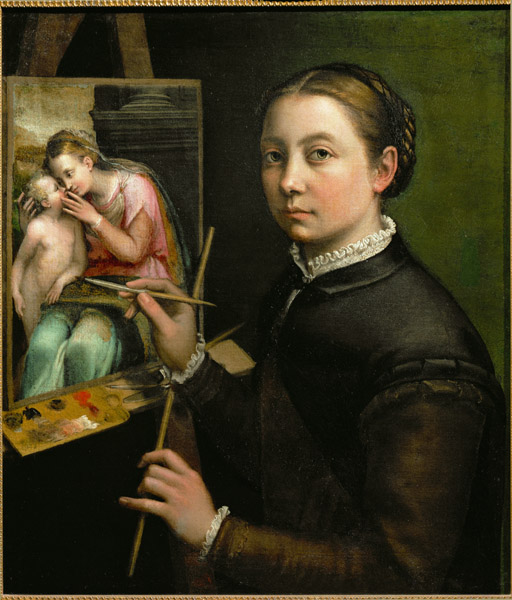First, with rare exceptions, artists were men. Into the seventeenth century, those few women known to us as artists were almost always artists’ daughters who learned in their fathers’ shops. Antonia, daughter of Paolo Uccello, for example, was said to know “how to draw.” Well into the baroque period, women artists were still regarded as “miracles of nature”—more felicitous but nearly as strange as two-headed calves (see A Woman Artist). Second, most artists came from the artisan class; many were the sons of artists or workers in related trades. Children of wealthy or aristocratic families rarely trained as artists because the manual and mechanical aspects of art production were considered beneath their dignity. Michelangelo, whose forebears had been part of the minor nobility, was one exception; increasingly, others followed (as we shall see later in this essay). Michelangelo’s family, however, was said to have been displeased by his decision to pursue art, which, according to one of his pupils, his father and uncles “hated.”
The same dearth was found at the other end of the social spectrum: few sons from peasant families became artists either, despite the fact that agricultural workers accounted for the greatest part of the Italian population. It is not likely that many peasant families considered art a viable way for a son to make a living. The training was too expensive and took away a productive member of the family for a period of years. Few farm families probably had much experience of “art.” A sort of folklore grew up about the handful of artists who did emerge from farm or shepherd families; it generally followed the model provided by Giotto, whose surprising and prodigious talent was said to have been recognized when Cimabue found the boy using a rock to scratch drawings on a stone while tending his flock. “Starlet at the lunch counter” stories like this one also figure in the biographies of Andrea del Castagno, Domenico Beccafumi, and Andrea Sansovino, all farmers’ sons.
A Woman Artist: Sofonisba Anguissola

Sofonisba Anguissola
Self-portrait, Painting the Madonna, 1556
Oil on canvas, 66 x 57 cm (26 x 22 2/5 in.)
Muzeum Zamek w Lancucie, Lancut, Poland
Erich Lessing/Art Resource, NY
Even in a work dedicated to describing 106 famous women—Boccaccio’s De claris mulieribus, finished in 1374—the author argued that “art is alien to the mind of women.”3 Attitudes did not change much over the next century; in fact, the growing drive to promote art as an intellectual activity—a capacity society found especially wanting in females—probably worked against it. Women were expected to appreciate art, not create it. Only in the first few decades of the sixteenth century did a handful of women make their mark as professional artists. When, in 1550, Giorgio Vasari published the first edition of his Le vite de più eccellenti architetti, pittori, et scultori . . . (Lives of the Most Excellent Architects, Painters, and Sculptors . . . ), a compendium of artist biographies and a cornerstone of art history (see Vasari and Art History), he included only one woman (see “Excerpts from Giorgio Vasari’s ‘Life of Madonna Properzia de’ Rossi,’ sculptor of Bologna”). The next edition, published eighteen years later, profiled thirteen women.
One of those women was Sofonisba Anguissola (see “Excerpts from Vasari’s description of Sofonisba Anguissola”). It has been argued that, other than Michelangelo and Titian, she was the most famous artist of the 1500s, even if much of that fame rested in her novelty. Collectors sought out her portrait as well as her work. In 1559, Philip II of Spain called her to Madrid to serve at his court as an attendant to the Infanta and a lady-in-waiting to the queen, to whom she gave painting lessons. The Anguissola family was among the minor nobility in the provincial town of Cremona, a circumstance highly important to the artist’s future: her rank meant that she not only learned to paint as a gentlewoman’s occupation but also received a good humanist education and exposure to all the arts. In addition to her talent for painting, she was praised for her sweet voice, knowledge of literature, and beauty. All these attributes made her a desirable presence at a royal court. She was taught to paint alongside her six sisters and practiced by painting them. One of her best-known works shows three sisters at a game of chess—a genre-like vignette that had never before been seen in Italy. Unusual for the time, her father not only gave his daughters a strong education in the humanities but was also an enthusiastic promoter of Sofonisba’s talents, even sending one of her drawings to Michelangelo.
![Felice Antonio Casone<br /><i>Lavinia Fontana</i>, (1552–1614), <i>Bolognese Painter</i> [obverse]; <i>Lavinia Fontana Painting</i> [reverse], 1611<br />Bronze, diameter 6.5 cm (2 9/16 in.)<br />National Gallery of Art, Washington, DC, Samuel H. Kress Collection<br />Image courtesy of the Board of Trustees, National Gallery of Art](http://italianrenaissanceresources.com/wp-content/uploads/2013/02/RP_1941-1.jpg)
Felice Antonio Casone
Lavinia Fontana, (1552–1614), Bolognese Painter [obverse]; Lavinia Fontana Painting [reverse], 1611
Bronze, diameter 6.5 cm (2 9/16 in.)
National Gallery of Art, Washington, DC, Samuel H. Kress Collection
Image courtesy of the Board of Trustees, National Gallery of Art